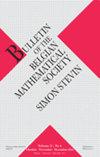混合型奇摄动微分差分方程的一致收敛数值方法
IF 0.6
4区 数学
Q4 MATHEMATICS
Bulletin of the Belgian Mathematical Society-Simon Stevin
Pub Date : 2020-12-01
DOI:10.36045/j.bbms.200128
引用次数: 1
摘要
本文研究一类具有时滞和超前的二阶线性微分差分方程的奇摄动问题。为了在数值上解决这一问题,我们利用积分恒等式的方法,利用积分形式的剩余项插值求积分规则,构造了一种新的差分格式。利用适当的非均匀Shishkin型网格,我们发现该方法在关于扰动参数的离散极大范数上几乎是一阶收敛的。此外,我们还进行了数值实验,其结果支持了这一理论。本文章由计算机程序翻译,如有差异,请以英文原文为准。
Uniformly convergent numerical method for a singularly perturbed differential difference equation with mixed type
In this paper, we deal with the singularly perturbed problem for a linear second order differential difference equation with delay as well as advance. In order to solve the problem numerically, we construct a new difference scheme by the method of integral identities with the use interpolating quadrature rules with remainder terms in integral form. Using an appropriately non-uniform mesh of Shishkin type, we find that the method is almost first order convergent in the discrete maximum norm with respect to the perturbation parameter. Furthermore, we present the numerical experiments that their results support of the theory.
求助全文
通过发布文献求助,成功后即可免费获取论文全文。
去求助
来源期刊
CiteScore
1.00
自引率
0.00%
发文量
14
审稿时长
6-12 weeks
期刊介绍:
The Bulletin of the Belgian Mathematical Society - Simon Stevin (BBMS) is a peer-reviewed journal devoted to recent developments in all areas in pure and applied mathematics. It is published as one yearly volume, containing five issues.
The main focus lies on high level original research papers. They should aim to a broader mathematical audience in the sense that a well-written introduction is attractive to mathematicians outside the circle of experts in the subject, bringing motivation, background information, history and philosophy. The content has to be substantial enough: short one-small-result papers will not be taken into account in general, unless there are some particular arguments motivating publication, like an original point of view, a new short proof of a famous result etc.
The BBMS also publishes expository papers that bring the state of the art of a current mainstream topic in mathematics. Here it is even more important that at leat a substantial part of the paper is accessible to a broader audience of mathematicians.
The BBMS publishes papers in English, Dutch, French and German. All papers should have an abstract in English.

 求助内容:
求助内容: 应助结果提醒方式:
应助结果提醒方式:


